Human Resource Development Report: Greenwood and Sharp Analysis
VerifiedAdded on 2020/12/29
|14
|3484
|361
Report
AI Summary
This report provides a comprehensive analysis of Human Resource Development (HRD) within the context of the Greenwood and Sharp organization. It begins by examining different learning styles, including Kolb's theory and its modifications, and explores the role of the learning curve and the importance of knowledge transfer in the workplace. The report then delves into planning and designing effective learning events by assessing the contributions of various learning styles. Furthermore, it compares training needs across different staff levels and evaluates the advantages and disadvantages of various training methods, including on-the-job and off-the-job approaches. A systematic approach to planning training and development events is presented, followed by an evaluation of training techniques and methods. The report also addresses the role of government in training, development, and lifelong learning, and assesses the impact of competency movements on both public and private sectors. Finally, it examines how contemporary UK government training initiatives contribute to HRD within organizations. The report concludes by summarizing the key findings and offering insights into the effectiveness of training and development programs.

Human Resource Development Assignment -
Greenwood
1
Greenwood
1
Paraphrase This Document
Need a fresh take? Get an instant paraphrase of this document with our AI Paraphraser
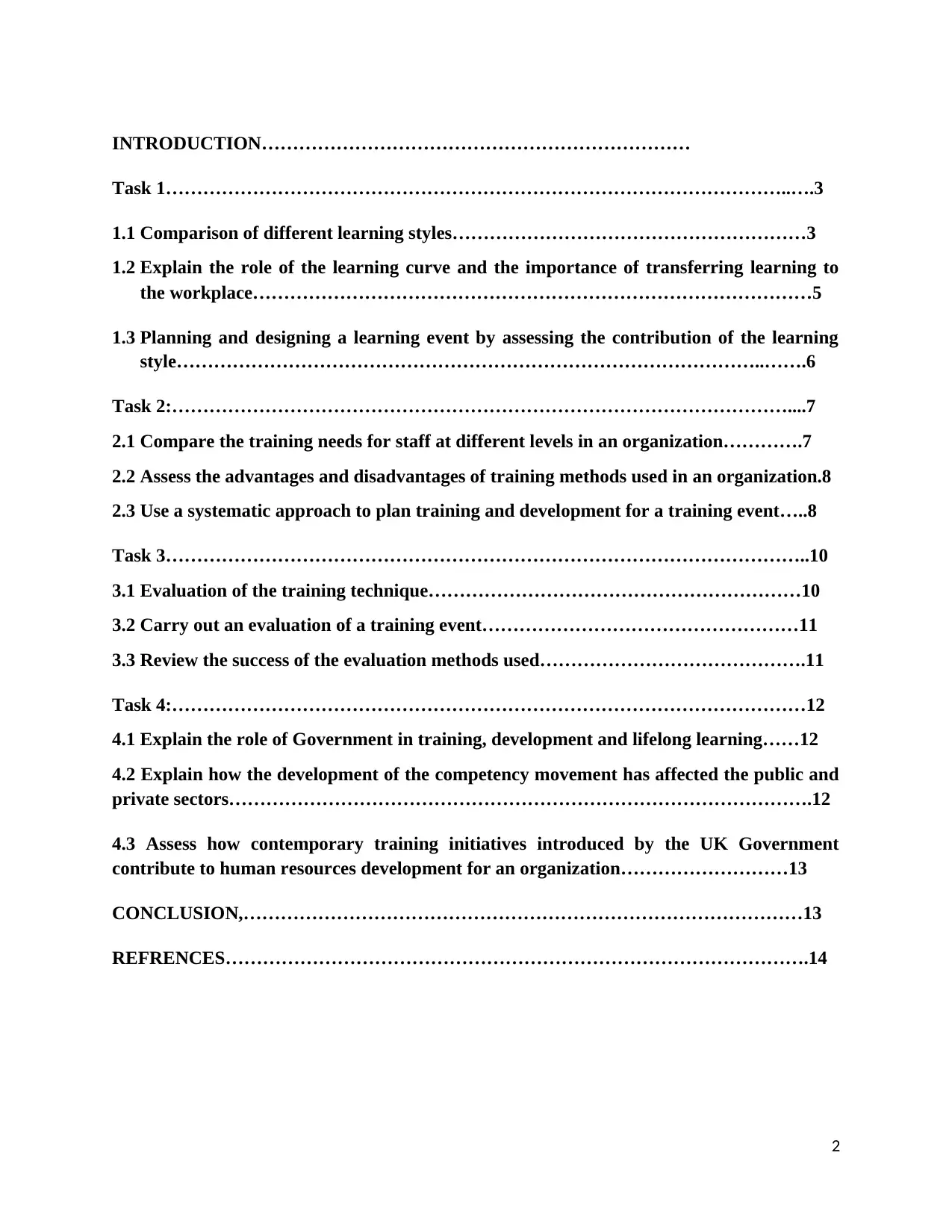
INTRODUCTION……………………………………………………………
Task 1………………………………………………………………………………………..….3
1.1 Comparison of different learning styles…………………………………………………3
1.2 Explain the role of the learning curve and the importance of transferring learning to
the workplace………………………………………………………………………………5
1.3 Planning and designing a learning event by assessing the contribution of the learning
style…………………………………………………………………………………..…….6
Task 2:………………………………………………………………………………………....7
2.1 Compare the training needs for staff at different levels in an organization………….7
2.2 Assess the advantages and disadvantages of training methods used in an organization.8
2.3 Use a systematic approach to plan training and development for a training event…..8
Task 3…………………………………………………………………………………………..10
3.1 Evaluation of the training technique……………………………………………………10
3.2 Carry out an evaluation of a training event……………………………………………11
3.3 Review the success of the evaluation methods used…………………………………….11
Task 4:…………………………………………………………………………………………12
4.1 Explain the role of Government in training, development and lifelong learning……12
4.2 Explain how the development of the competency movement has affected the public and
private sectors………………………………………………………………………………….12
4.3 Assess how contemporary training initiatives introduced by the UK Government
contribute to human resources development for an organization………………………13
CONCLUSION,………………………………………………………………………………13
REFRENCES………………………………………………………………………………….14
2
Task 1………………………………………………………………………………………..….3
1.1 Comparison of different learning styles…………………………………………………3
1.2 Explain the role of the learning curve and the importance of transferring learning to
the workplace………………………………………………………………………………5
1.3 Planning and designing a learning event by assessing the contribution of the learning
style…………………………………………………………………………………..…….6
Task 2:………………………………………………………………………………………....7
2.1 Compare the training needs for staff at different levels in an organization………….7
2.2 Assess the advantages and disadvantages of training methods used in an organization.8
2.3 Use a systematic approach to plan training and development for a training event…..8
Task 3…………………………………………………………………………………………..10
3.1 Evaluation of the training technique……………………………………………………10
3.2 Carry out an evaluation of a training event……………………………………………11
3.3 Review the success of the evaluation methods used…………………………………….11
Task 4:…………………………………………………………………………………………12
4.1 Explain the role of Government in training, development and lifelong learning……12
4.2 Explain how the development of the competency movement has affected the public and
private sectors………………………………………………………………………………….12
4.3 Assess how contemporary training initiatives introduced by the UK Government
contribute to human resources development for an organization………………………13
CONCLUSION,………………………………………………………………………………13
REFRENCES………………………………………………………………………………….14
2
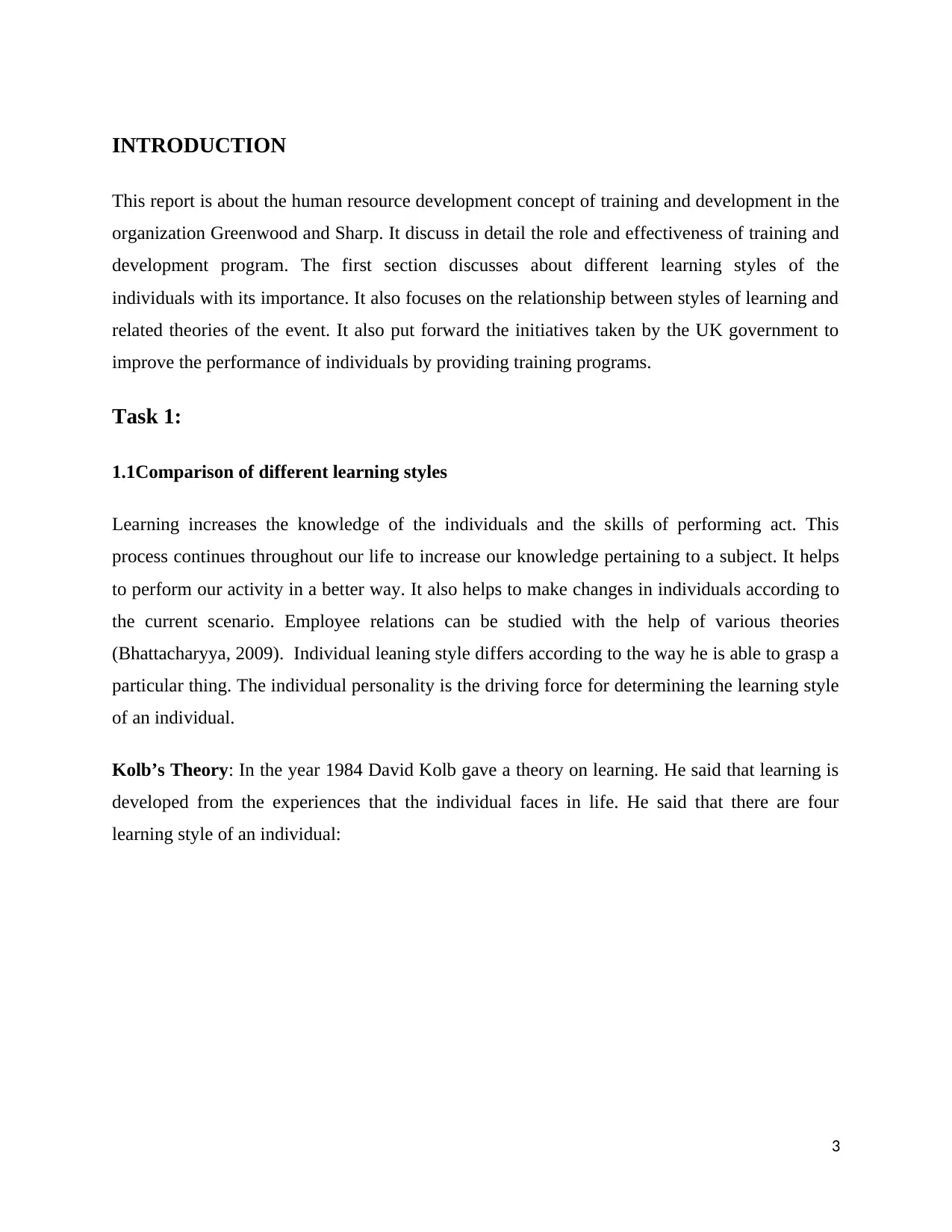
INTRODUCTION
This report is about the human resource development concept of training and development in the
organization Greenwood and Sharp. It discuss in detail the role and effectiveness of training and
development program. The first section discusses about different learning styles of the
individuals with its importance. It also focuses on the relationship between styles of learning and
related theories of the event. It also put forward the initiatives taken by the UK government to
improve the performance of individuals by providing training programs.
Task 1:
1.1Comparison of different learning styles
Learning increases the knowledge of the individuals and the skills of performing act. This
process continues throughout our life to increase our knowledge pertaining to a subject. It helps
to perform our activity in a better way. It also helps to make changes in individuals according to
the current scenario. Employee relations can be studied with the help of various theories
(Bhattacharyya, 2009). Individual leaning style differs according to the way he is able to grasp a
particular thing. The individual personality is the driving force for determining the learning style
of an individual.
Kolb’s Theory: In the year 1984 David Kolb gave a theory on learning. He said that learning is
developed from the experiences that the individual faces in life. He said that there are four
learning style of an individual:
3
This report is about the human resource development concept of training and development in the
organization Greenwood and Sharp. It discuss in detail the role and effectiveness of training and
development program. The first section discusses about different learning styles of the
individuals with its importance. It also focuses on the relationship between styles of learning and
related theories of the event. It also put forward the initiatives taken by the UK government to
improve the performance of individuals by providing training programs.
Task 1:
1.1Comparison of different learning styles
Learning increases the knowledge of the individuals and the skills of performing act. This
process continues throughout our life to increase our knowledge pertaining to a subject. It helps
to perform our activity in a better way. It also helps to make changes in individuals according to
the current scenario. Employee relations can be studied with the help of various theories
(Bhattacharyya, 2009). Individual leaning style differs according to the way he is able to grasp a
particular thing. The individual personality is the driving force for determining the learning style
of an individual.
Kolb’s Theory: In the year 1984 David Kolb gave a theory on learning. He said that learning is
developed from the experiences that the individual faces in life. He said that there are four
learning style of an individual:
3
⊘ This is a preview!⊘
Do you want full access?
Subscribe today to unlock all pages.

Trusted by 1+ million students worldwide

Diverging: They develop their learning from the things they see and feel. These people imagine
thing and bring solution to a problem by the help of idea generation.
Assimilating: They are the people who develop learning with the help of seeing and thinking
things. They give logical answer to the problem they have in life.
Converging: They believe in the practical thinking that they develop through their life
experience.
Accommodating: This kind of people solves things according to their practical experience rather
than the logics of solving things.
The theory of Kolb is modified by Honey and Mumford
4
thing and bring solution to a problem by the help of idea generation.
Assimilating: They are the people who develop learning with the help of seeing and thinking
things. They give logical answer to the problem they have in life.
Converging: They believe in the practical thinking that they develop through their life
experience.
Accommodating: This kind of people solves things according to their practical experience rather
than the logics of solving things.
The theory of Kolb is modified by Honey and Mumford
4
Paraphrase This Document
Need a fresh take? Get an instant paraphrase of this document with our AI Paraphraser
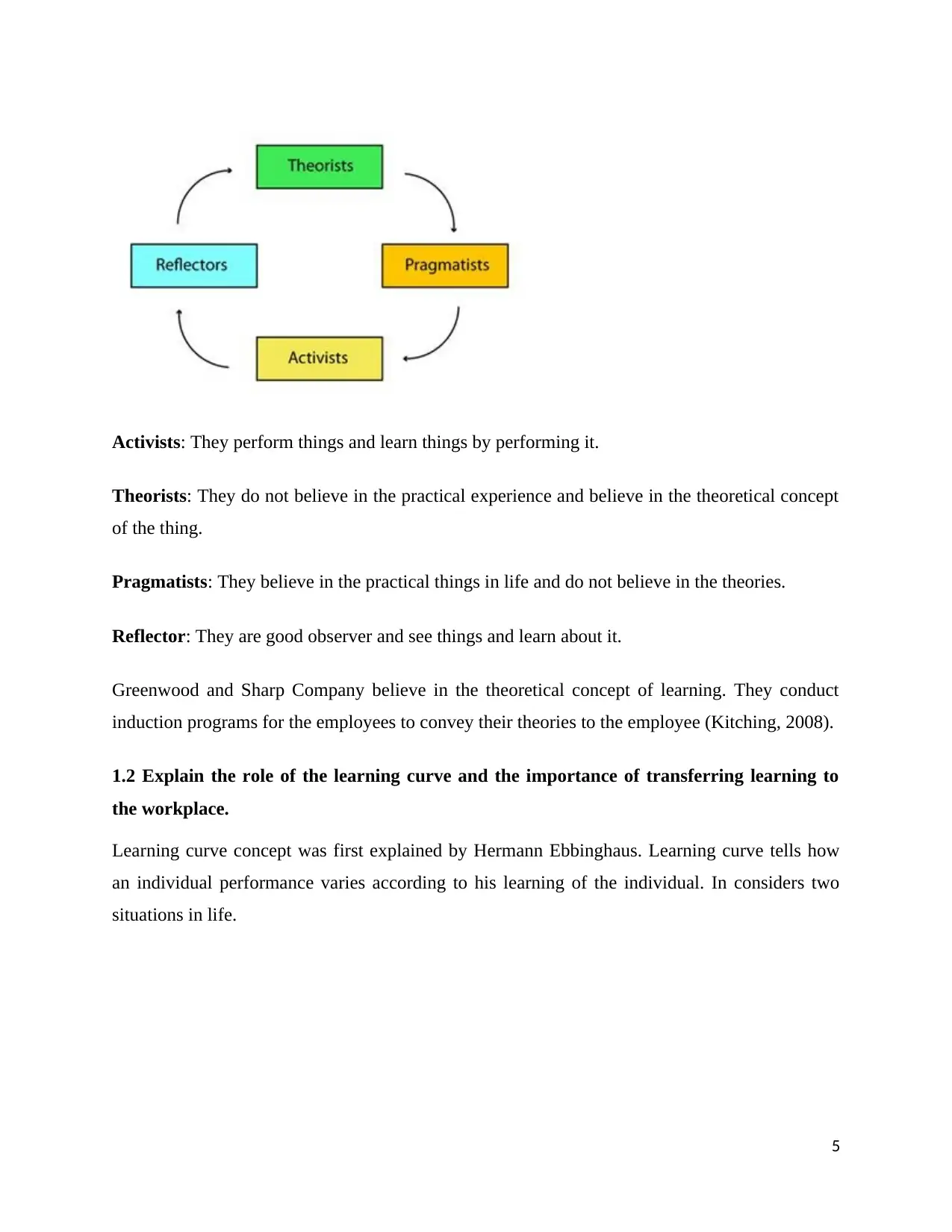
Activists: They perform things and learn things by performing it.
Theorists: They do not believe in the practical experience and believe in the theoretical concept
of the thing.
Pragmatists: They believe in the practical things in life and do not believe in the theories.
Reflector: They are good observer and see things and learn about it.
Greenwood and Sharp Company believe in the theoretical concept of learning. They conduct
induction programs for the employees to convey their theories to the employee (Kitching, 2008).
1.2 Explain the role of the learning curve and the importance of transferring learning to
the workplace.
Learning curve concept was first explained by Hermann Ebbinghaus. Learning curve tells how
an individual performance varies according to his learning of the individual. In considers two
situations in life.
5
Theorists: They do not believe in the practical experience and believe in the theoretical concept
of the thing.
Pragmatists: They believe in the practical things in life and do not believe in the theories.
Reflector: They are good observer and see things and learn about it.
Greenwood and Sharp Company believe in the theoretical concept of learning. They conduct
induction programs for the employees to convey their theories to the employee (Kitching, 2008).
1.2 Explain the role of the learning curve and the importance of transferring learning to
the workplace.
Learning curve concept was first explained by Hermann Ebbinghaus. Learning curve tells how
an individual performance varies according to his learning of the individual. In considers two
situations in life.
5

The graph shows that the performance of the individual increases if they are provided with
training in the organization.
Importance of Knowledge transfer: The knowledge transfer helps in the beginning phase of
the job and develops the skills of the employee. There should be a systematic plan of transfer of
knowledge from the giver to the taker. Knowledge among the employee is transferred through
the training. It is very helpful in the retention of the new employee.
Role Of learning curve: It tells the performance of the individual within the organization. It tells
the position of the individual in the organization. The learning of the individual can be judged by
monitoring the learning points. Learning curve is the combination of the learning points
(Mankin, 2009).
1.3 Planning and designing a learning event by assessing the contribution of the learning
style.
The transferring of the knowledge within the organization and giving different ways to grasp the
knowledge can be judged by the learning styles. The learning style differs from the employee to
employee of the organization. It is also dependent on the time spent on learning a style. The
learning style should be transferred after seeing the employee and the time period at which it is
being transferred (Piskurich, 2009).
A learning program cannot be completed by one learning style. There should be a combination of
different learning style to be transferred during the training sessions. Event also defines the
learning style to be transferred. Training program should be planned after choosing the learning
style. It is dependent on how people understand it. Learning theories is helpful in understanding
6
training in the organization.
Importance of Knowledge transfer: The knowledge transfer helps in the beginning phase of
the job and develops the skills of the employee. There should be a systematic plan of transfer of
knowledge from the giver to the taker. Knowledge among the employee is transferred through
the training. It is very helpful in the retention of the new employee.
Role Of learning curve: It tells the performance of the individual within the organization. It tells
the position of the individual in the organization. The learning of the individual can be judged by
monitoring the learning points. Learning curve is the combination of the learning points
(Mankin, 2009).
1.3 Planning and designing a learning event by assessing the contribution of the learning
style.
The transferring of the knowledge within the organization and giving different ways to grasp the
knowledge can be judged by the learning styles. The learning style differs from the employee to
employee of the organization. It is also dependent on the time spent on learning a style. The
learning style should be transferred after seeing the employee and the time period at which it is
being transferred (Piskurich, 2009).
A learning program cannot be completed by one learning style. There should be a combination of
different learning style to be transferred during the training sessions. Event also defines the
learning style to be transferred. Training program should be planned after choosing the learning
style. It is dependent on how people understand it. Learning theories is helpful in understanding
6
⊘ This is a preview!⊘
Do you want full access?
Subscribe today to unlock all pages.

Trusted by 1+ million students worldwide

the personality of the individual and then transferring the learning style. An organization has to
study the behavior of the trainee and then decide the learning style to be transferred. In the
induction program of the organization the employee should be made aware about the different
learning styles in the organizations (Mazenod, 2013)
The trainer will learn a learning style dependent on the event and the learning style. The learning
style should complement the program designed. If pragmatic learning is to be included then it
should be about the role the employee has to perform and the practical exposure of the employee
should be more.
Task 2:
2.1 Compare the training needs for staff at different levels in an organization.
The training differs from on the basis of the level to which the employee belongs. If the
employee is at the top level he needs training with respect to the decisional role. Training should
be giving after assessing the current status of the employee and knowing the future demand from
the employee (Reid, 2005).
Management Level
Senior management level: They are the people who are involved in making the strategies for the
organization. Training should be provided that will help the employee in strategies formulation.
They should be able to built strategies on the bais of the goal and objectives of the organization.
Low level management: At this level training should be provided to the employees who have less
experience so that their work commitment and skills regarding the task increases.
Operational Level
Senior management: At this level the new employees who have joined the organization should be
aware about the vision and mission of the organization. They should be made familiar what the
organization expects out of them.
Employee need: The training should be provided to the employee so that they match the current
need of the organization (Steffens, 2015).
7
study the behavior of the trainee and then decide the learning style to be transferred. In the
induction program of the organization the employee should be made aware about the different
learning styles in the organizations (Mazenod, 2013)
The trainer will learn a learning style dependent on the event and the learning style. The learning
style should complement the program designed. If pragmatic learning is to be included then it
should be about the role the employee has to perform and the practical exposure of the employee
should be more.
Task 2:
2.1 Compare the training needs for staff at different levels in an organization.
The training differs from on the basis of the level to which the employee belongs. If the
employee is at the top level he needs training with respect to the decisional role. Training should
be giving after assessing the current status of the employee and knowing the future demand from
the employee (Reid, 2005).
Management Level
Senior management level: They are the people who are involved in making the strategies for the
organization. Training should be provided that will help the employee in strategies formulation.
They should be able to built strategies on the bais of the goal and objectives of the organization.
Low level management: At this level training should be provided to the employees who have less
experience so that their work commitment and skills regarding the task increases.
Operational Level
Senior management: At this level the new employees who have joined the organization should be
aware about the vision and mission of the organization. They should be made familiar what the
organization expects out of them.
Employee need: The training should be provided to the employee so that they match the current
need of the organization (Steffens, 2015).
7
Paraphrase This Document
Need a fresh take? Get an instant paraphrase of this document with our AI Paraphraser

2.2 Assess the advantages and disadvantages of training methods used in an organization.
Training methods: It deals with the training sessions that are to be provided to the employee in
the organization. The training differs from the level of the management. In case of the induction
program the employee should be made aware about the vision and the mission of the
organization. They should be aware what the organization expects from the employee of the
organization. Basically there are two type of training program, on the job training and off the job
training. This company is focusing on the job training methods in the organization. It is done
when the employee are performing their role related duties (Turner, 2007)
On job training is of various types as discussed below:
Simulation and role play: In this the actual environment of the organization is created in which
the employee has to work. He is provided with the practical experience of the organization. But
in creating such an environment the organization has to incur lots of money.
Coaching: It is a theoretical experience to the employee about the atmosphere in which the
employee has to work. It lacks the practical experience of the work life through which the
employee has to go through. This is not a expensive method of giving training.
Mentoring: This is a session given by the higher level employee to the lower level employee. It
is a type of method where sessions are given by the employee. But this gets boring and tiring if
the time duration of the session increases. The trainee if feels boring may not listen to the
session. It lacks the practical experience of the work life through which the employee has to go
through. This is not a expensive method of giving training (Werner and DeSimone, 2006).
Job Instructional technique: In this in depth study related to the job is done. The employee is
guided step by step performance in a task. The trainee has to be very attentive while taking such
training program. Therefore if the employee misses one of the next steps he cannot connect with
the next step of the training.
2.3 Use a systematic approach to plan training and development for a training event
Training and development planning: Training program need to be planned systematically to
gets the end result. It should be continuous cycle that increases the learning of the individual.
The cyclic process includes:
8
Training methods: It deals with the training sessions that are to be provided to the employee in
the organization. The training differs from the level of the management. In case of the induction
program the employee should be made aware about the vision and the mission of the
organization. They should be aware what the organization expects from the employee of the
organization. Basically there are two type of training program, on the job training and off the job
training. This company is focusing on the job training methods in the organization. It is done
when the employee are performing their role related duties (Turner, 2007)
On job training is of various types as discussed below:
Simulation and role play: In this the actual environment of the organization is created in which
the employee has to work. He is provided with the practical experience of the organization. But
in creating such an environment the organization has to incur lots of money.
Coaching: It is a theoretical experience to the employee about the atmosphere in which the
employee has to work. It lacks the practical experience of the work life through which the
employee has to go through. This is not a expensive method of giving training.
Mentoring: This is a session given by the higher level employee to the lower level employee. It
is a type of method where sessions are given by the employee. But this gets boring and tiring if
the time duration of the session increases. The trainee if feels boring may not listen to the
session. It lacks the practical experience of the work life through which the employee has to go
through. This is not a expensive method of giving training (Werner and DeSimone, 2006).
Job Instructional technique: In this in depth study related to the job is done. The employee is
guided step by step performance in a task. The trainee has to be very attentive while taking such
training program. Therefore if the employee misses one of the next steps he cannot connect with
the next step of the training.
2.3 Use a systematic approach to plan training and development for a training event
Training and development planning: Training program need to be planned systematically to
gets the end result. It should be continuous cycle that increases the learning of the individual.
The cyclic process includes:
8
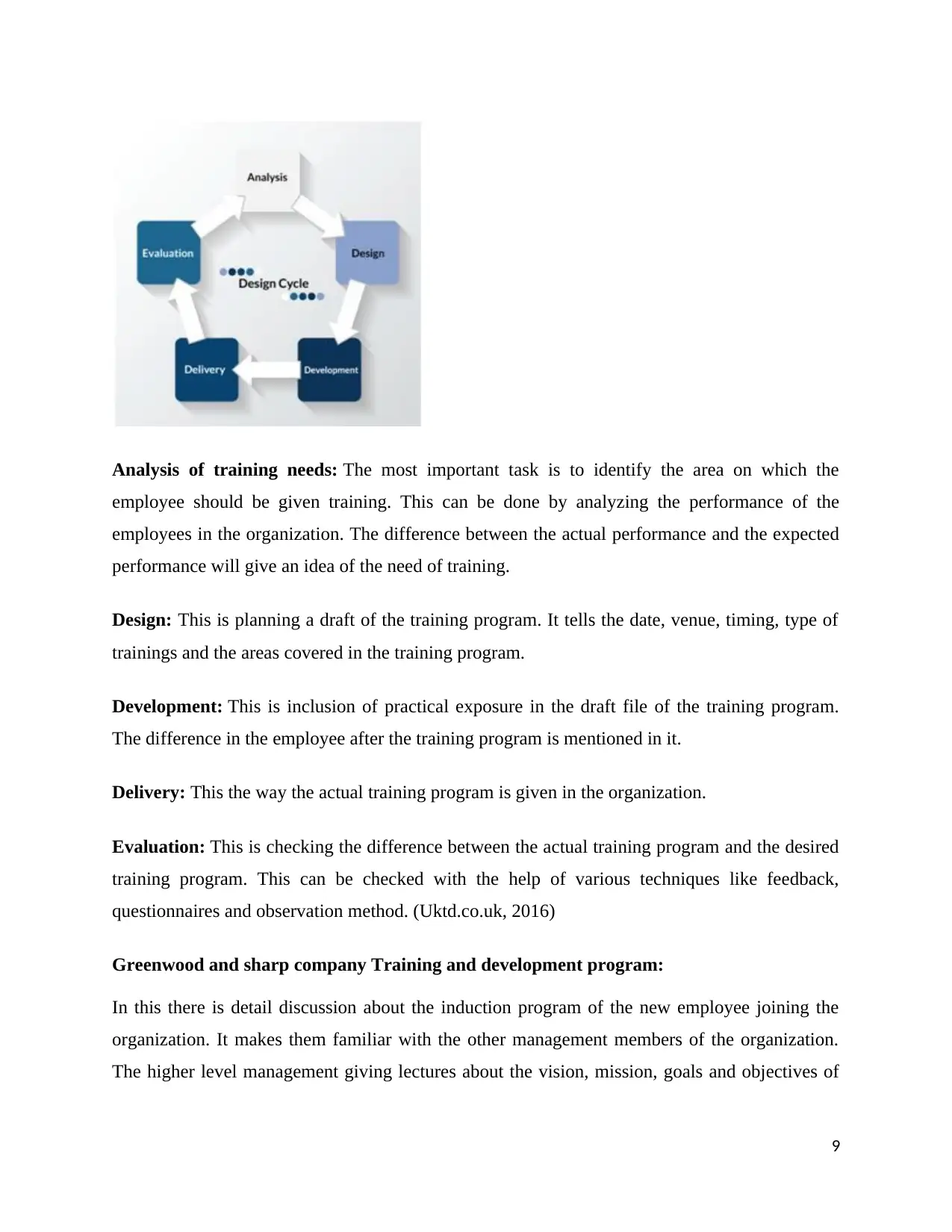
Analysis of training needs: The most important task is to identify the area on which the
employee should be given training. This can be done by analyzing the performance of the
employees in the organization. The difference between the actual performance and the expected
performance will give an idea of the need of training.
Design: This is planning a draft of the training program. It tells the date, venue, timing, type of
trainings and the areas covered in the training program.
Development: This is inclusion of practical exposure in the draft file of the training program.
The difference in the employee after the training program is mentioned in it.
Delivery: This the way the actual training program is given in the organization.
Evaluation: This is checking the difference between the actual training program and the desired
training program. This can be checked with the help of various techniques like feedback,
questionnaires and observation method. (Uktd.co.uk, 2016)
Greenwood and sharp company Training and development program:
In this there is detail discussion about the induction program of the new employee joining the
organization. It makes them familiar with the other management members of the organization.
The higher level management giving lectures about the vision, mission, goals and objectives of
9
employee should be given training. This can be done by analyzing the performance of the
employees in the organization. The difference between the actual performance and the expected
performance will give an idea of the need of training.
Design: This is planning a draft of the training program. It tells the date, venue, timing, type of
trainings and the areas covered in the training program.
Development: This is inclusion of practical exposure in the draft file of the training program.
The difference in the employee after the training program is mentioned in it.
Delivery: This the way the actual training program is given in the organization.
Evaluation: This is checking the difference between the actual training program and the desired
training program. This can be checked with the help of various techniques like feedback,
questionnaires and observation method. (Uktd.co.uk, 2016)
Greenwood and sharp company Training and development program:
In this there is detail discussion about the induction program of the new employee joining the
organization. It makes them familiar with the other management members of the organization.
The higher level management giving lectures about the vision, mission, goals and objectives of
9
⊘ This is a preview!⊘
Do you want full access?
Subscribe today to unlock all pages.

Trusted by 1+ million students worldwide
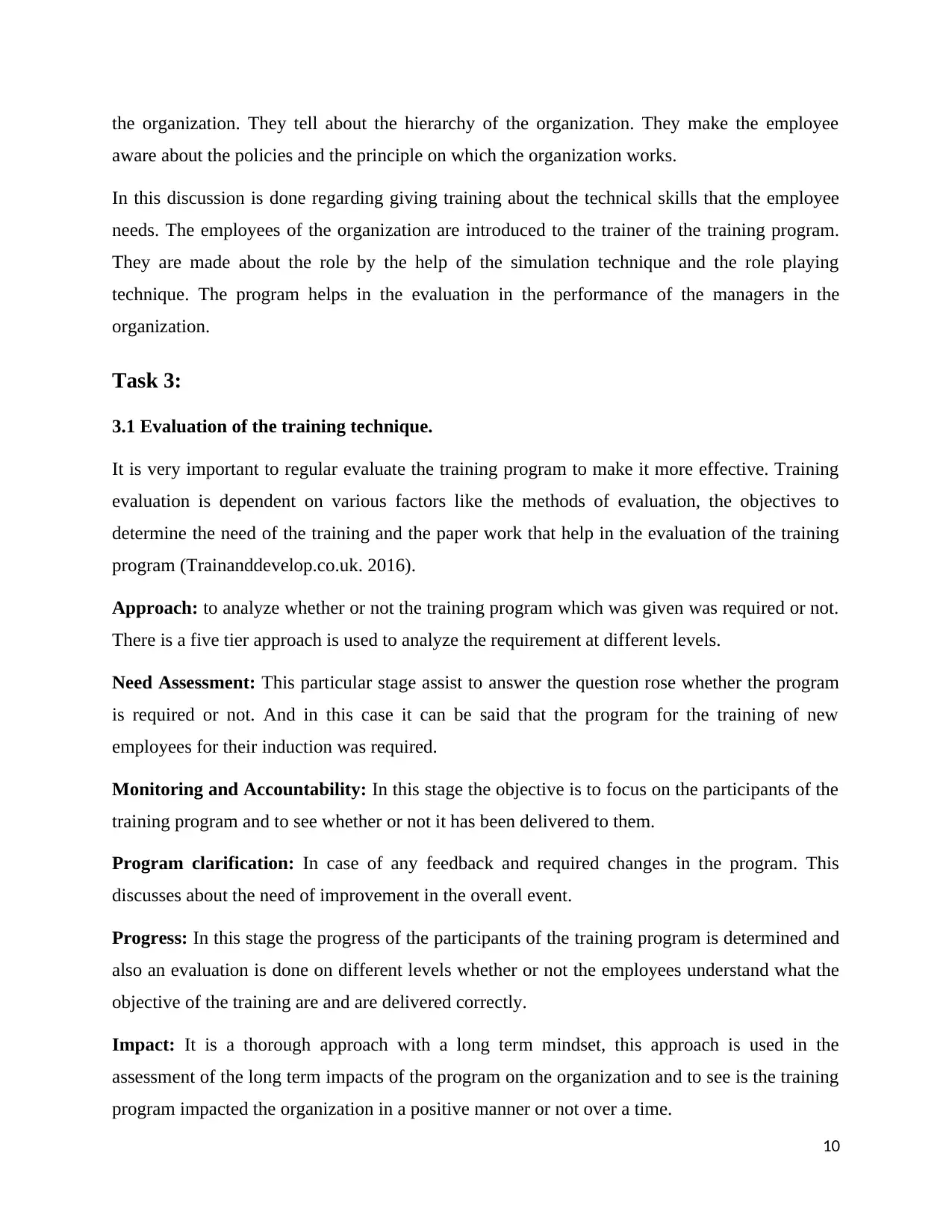
the organization. They tell about the hierarchy of the organization. They make the employee
aware about the policies and the principle on which the organization works.
In this discussion is done regarding giving training about the technical skills that the employee
needs. The employees of the organization are introduced to the trainer of the training program.
They are made about the role by the help of the simulation technique and the role playing
technique. The program helps in the evaluation in the performance of the managers in the
organization.
Task 3:
3.1 Evaluation of the training technique.
It is very important to regular evaluate the training program to make it more effective. Training
evaluation is dependent on various factors like the methods of evaluation, the objectives to
determine the need of the training and the paper work that help in the evaluation of the training
program (Trainanddevelop.co.uk. 2016).
Approach: to analyze whether or not the training program which was given was required or not.
There is a five tier approach is used to analyze the requirement at different levels.
Need Assessment: This particular stage assist to answer the question rose whether the program
is required or not. And in this case it can be said that the program for the training of new
employees for their induction was required.
Monitoring and Accountability: In this stage the objective is to focus on the participants of the
training program and to see whether or not it has been delivered to them.
Program clarification: In case of any feedback and required changes in the program. This
discusses about the need of improvement in the overall event.
Progress: In this stage the progress of the participants of the training program is determined and
also an evaluation is done on different levels whether or not the employees understand what the
objective of the training are and are delivered correctly.
Impact: It is a thorough approach with a long term mindset, this approach is used in the
assessment of the long term impacts of the program on the organization and to see is the training
program impacted the organization in a positive manner or not over a time.
10
aware about the policies and the principle on which the organization works.
In this discussion is done regarding giving training about the technical skills that the employee
needs. The employees of the organization are introduced to the trainer of the training program.
They are made about the role by the help of the simulation technique and the role playing
technique. The program helps in the evaluation in the performance of the managers in the
organization.
Task 3:
3.1 Evaluation of the training technique.
It is very important to regular evaluate the training program to make it more effective. Training
evaluation is dependent on various factors like the methods of evaluation, the objectives to
determine the need of the training and the paper work that help in the evaluation of the training
program (Trainanddevelop.co.uk. 2016).
Approach: to analyze whether or not the training program which was given was required or not.
There is a five tier approach is used to analyze the requirement at different levels.
Need Assessment: This particular stage assist to answer the question rose whether the program
is required or not. And in this case it can be said that the program for the training of new
employees for their induction was required.
Monitoring and Accountability: In this stage the objective is to focus on the participants of the
training program and to see whether or not it has been delivered to them.
Program clarification: In case of any feedback and required changes in the program. This
discusses about the need of improvement in the overall event.
Progress: In this stage the progress of the participants of the training program is determined and
also an evaluation is done on different levels whether or not the employees understand what the
objective of the training are and are delivered correctly.
Impact: It is a thorough approach with a long term mindset, this approach is used in the
assessment of the long term impacts of the program on the organization and to see is the training
program impacted the organization in a positive manner or not over a time.
10
Paraphrase This Document
Need a fresh take? Get an instant paraphrase of this document with our AI Paraphraser
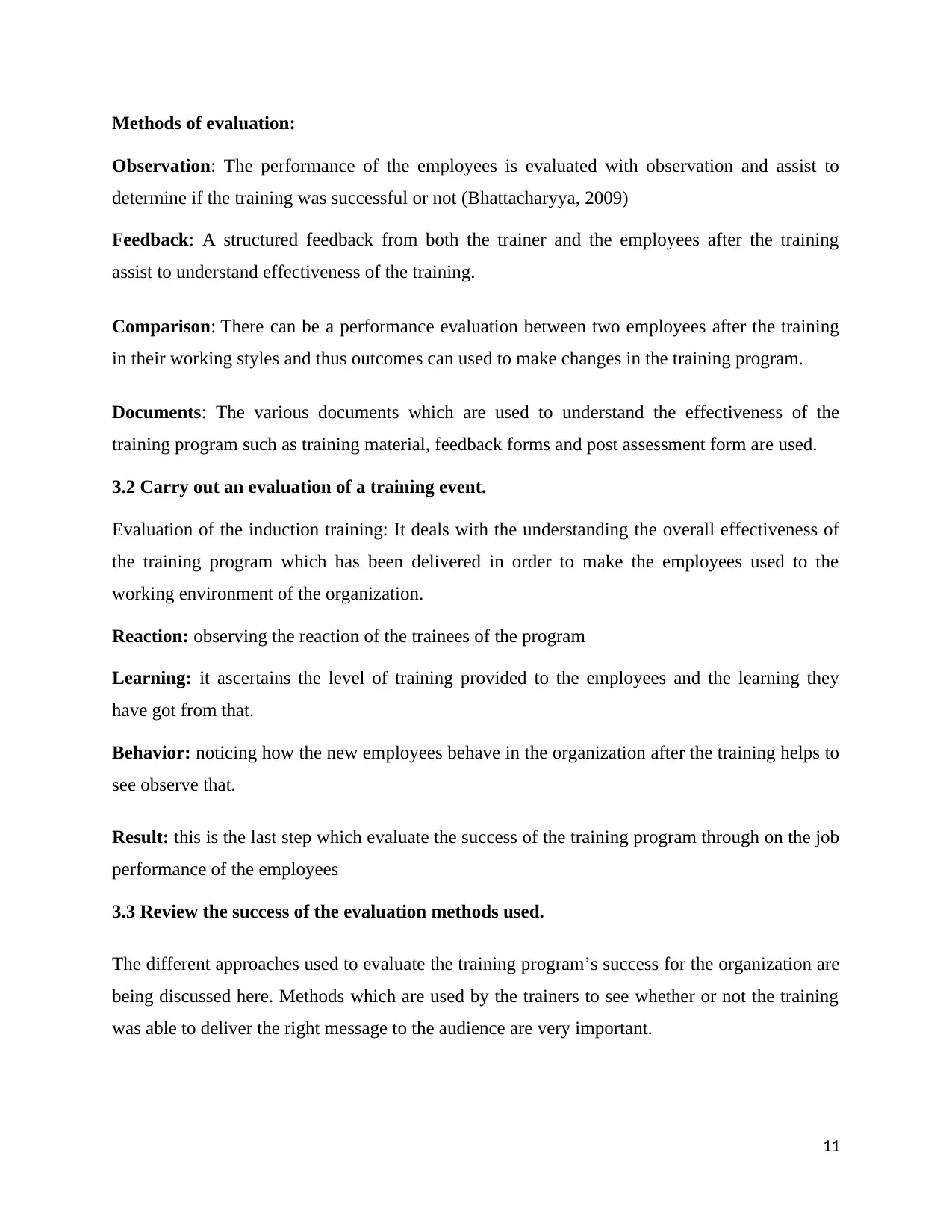
Methods of evaluation:
Observation: The performance of the employees is evaluated with observation and assist to
determine if the training was successful or not (Bhattacharyya, 2009)
Feedback: A structured feedback from both the trainer and the employees after the training
assist to understand effectiveness of the training.
Comparison: There can be a performance evaluation between two employees after the training
in their working styles and thus outcomes can used to make changes in the training program.
Documents: The various documents which are used to understand the effectiveness of the
training program such as training material, feedback forms and post assessment form are used.
3.2 Carry out an evaluation of a training event.
Evaluation of the induction training: It deals with the understanding the overall effectiveness of
the training program which has been delivered in order to make the employees used to the
working environment of the organization.
Reaction: observing the reaction of the trainees of the program
Learning: it ascertains the level of training provided to the employees and the learning they
have got from that.
Behavior: noticing how the new employees behave in the organization after the training helps to
see observe that.
Result: this is the last step which evaluate the success of the training program through on the job
performance of the employees
3.3 Review the success of the evaluation methods used.
The different approaches used to evaluate the training program’s success for the organization are
being discussed here. Methods which are used by the trainers to see whether or not the training
was able to deliver the right message to the audience are very important.
11
Observation: The performance of the employees is evaluated with observation and assist to
determine if the training was successful or not (Bhattacharyya, 2009)
Feedback: A structured feedback from both the trainer and the employees after the training
assist to understand effectiveness of the training.
Comparison: There can be a performance evaluation between two employees after the training
in their working styles and thus outcomes can used to make changes in the training program.
Documents: The various documents which are used to understand the effectiveness of the
training program such as training material, feedback forms and post assessment form are used.
3.2 Carry out an evaluation of a training event.
Evaluation of the induction training: It deals with the understanding the overall effectiveness of
the training program which has been delivered in order to make the employees used to the
working environment of the organization.
Reaction: observing the reaction of the trainees of the program
Learning: it ascertains the level of training provided to the employees and the learning they
have got from that.
Behavior: noticing how the new employees behave in the organization after the training helps to
see observe that.
Result: this is the last step which evaluate the success of the training program through on the job
performance of the employees
3.3 Review the success of the evaluation methods used.
The different approaches used to evaluate the training program’s success for the organization are
being discussed here. Methods which are used by the trainers to see whether or not the training
was able to deliver the right message to the audience are very important.
11
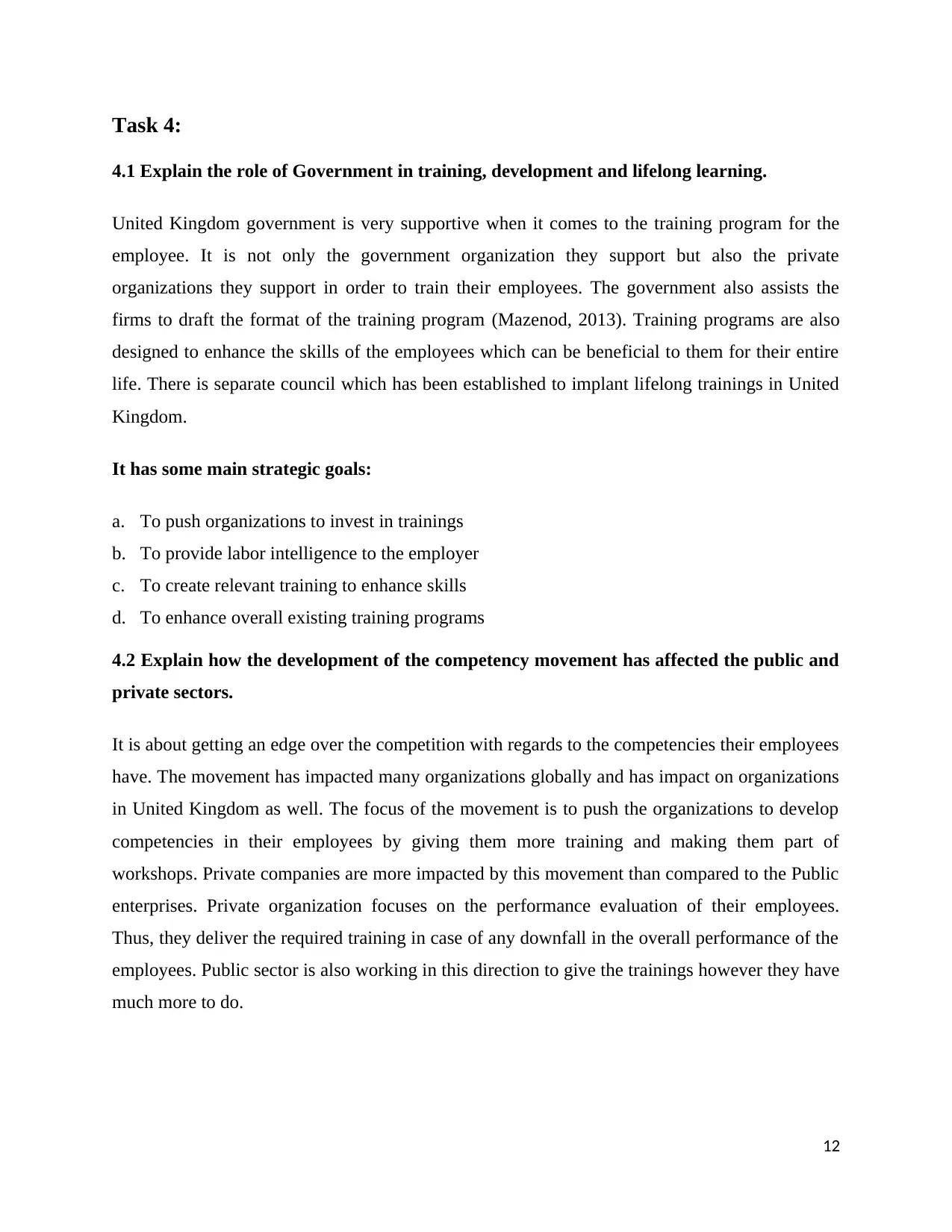
Task 4:
4.1 Explain the role of Government in training, development and lifelong learning.
United Kingdom government is very supportive when it comes to the training program for the
employee. It is not only the government organization they support but also the private
organizations they support in order to train their employees. The government also assists the
firms to draft the format of the training program (Mazenod, 2013). Training programs are also
designed to enhance the skills of the employees which can be beneficial to them for their entire
life. There is separate council which has been established to implant lifelong trainings in United
Kingdom.
It has some main strategic goals:
a. To push organizations to invest in trainings
b. To provide labor intelligence to the employer
c. To create relevant training to enhance skills
d. To enhance overall existing training programs
4.2 Explain how the development of the competency movement has affected the public and
private sectors.
It is about getting an edge over the competition with regards to the competencies their employees
have. The movement has impacted many organizations globally and has impact on organizations
in United Kingdom as well. The focus of the movement is to push the organizations to develop
competencies in their employees by giving them more training and making them part of
workshops. Private companies are more impacted by this movement than compared to the Public
enterprises. Private organization focuses on the performance evaluation of their employees.
Thus, they deliver the required training in case of any downfall in the overall performance of the
employees. Public sector is also working in this direction to give the trainings however they have
much more to do.
12
4.1 Explain the role of Government in training, development and lifelong learning.
United Kingdom government is very supportive when it comes to the training program for the
employee. It is not only the government organization they support but also the private
organizations they support in order to train their employees. The government also assists the
firms to draft the format of the training program (Mazenod, 2013). Training programs are also
designed to enhance the skills of the employees which can be beneficial to them for their entire
life. There is separate council which has been established to implant lifelong trainings in United
Kingdom.
It has some main strategic goals:
a. To push organizations to invest in trainings
b. To provide labor intelligence to the employer
c. To create relevant training to enhance skills
d. To enhance overall existing training programs
4.2 Explain how the development of the competency movement has affected the public and
private sectors.
It is about getting an edge over the competition with regards to the competencies their employees
have. The movement has impacted many organizations globally and has impact on organizations
in United Kingdom as well. The focus of the movement is to push the organizations to develop
competencies in their employees by giving them more training and making them part of
workshops. Private companies are more impacted by this movement than compared to the Public
enterprises. Private organization focuses on the performance evaluation of their employees.
Thus, they deliver the required training in case of any downfall in the overall performance of the
employees. Public sector is also working in this direction to give the trainings however they have
much more to do.
12
⊘ This is a preview!⊘
Do you want full access?
Subscribe today to unlock all pages.

Trusted by 1+ million students worldwide
1 out of 14
Related Documents
Your All-in-One AI-Powered Toolkit for Academic Success.
+13062052269
info@desklib.com
Available 24*7 on WhatsApp / Email
![[object Object]](/_next/static/media/star-bottom.7253800d.svg)
Unlock your academic potential
Copyright © 2020–2025 A2Z Services. All Rights Reserved. Developed and managed by ZUCOL.





